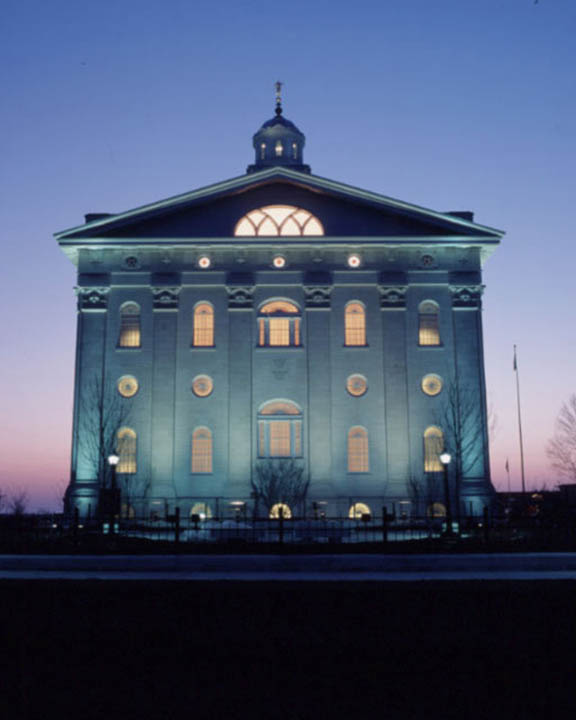After the abortive attempts to build temples in Missouri, both in Jackson County and later in Far West, Daviess County, the Mormons built their first true temple in Nauvoo, Illinois. In late 1838, the Mormons had been forcibly expelled from Missouri by the infamous Extermination Order, which decreed that all Mormons who would not flee the state would be murdered. The Latter-day Saints, as they were called, settled in Commerce, Illinois, which they renamed Nauvoo. For the Prophet Joseph Smith, building the temple was of supreme importance. He dedicated the last few years of his life to completing the temple. On May 4, 1844, less than two months before his murder, Joseph Smith said, “We need the temple more than anything else” (Journal History of the Church, May 4, 1844).
 On April 6, 1841, the Mormon temple was begun at the same time as Joseph Smith began preaching the doctrine of baptism for the dead, which he had received by revelation. He taught that those who had died without an opportunity to hear the true gospel of Jesus Christ would be taught it in the Spirit World and have the chance to accept it. Those who were still living upon the earth could be baptized on their behalf. This doctrine, unique to Mormonism, even though the Bible refers to it (see 1 Corinthians 15:29), also taught that such ordinances were to be done in temples along with other sacred temple ceremonies. Just as with Solomon’s Temple, the Lord revealed to Joseph Smith the plan and layout of the temple, which included a baptistery, a large meeting hall, offices for some Mormon Church leaders, and special ordinance rooms. In the spring of 1842, Joseph Smith introduced other Mormon temple ordinances, known as the Endowment, to the Twelve Apostles. He also taught about Celestial or Eternal Marriage, which was to be performed in temples and through which a husband and wife could be “sealed” together for time and eternity along with their children, and thus could receive all the blessings of Abraham. No one else besides the Twelve Apostles and their wives received these ordinances until after the temple was finished. Joseph Smith, knowing that he probably would die before the temple was completed, introduced them in the upper room of his general store called the Red Brick Store.
On April 6, 1841, the Mormon temple was begun at the same time as Joseph Smith began preaching the doctrine of baptism for the dead, which he had received by revelation. He taught that those who had died without an opportunity to hear the true gospel of Jesus Christ would be taught it in the Spirit World and have the chance to accept it. Those who were still living upon the earth could be baptized on their behalf. This doctrine, unique to Mormonism, even though the Bible refers to it (see 1 Corinthians 15:29), also taught that such ordinances were to be done in temples along with other sacred temple ceremonies. Just as with Solomon’s Temple, the Lord revealed to Joseph Smith the plan and layout of the temple, which included a baptistery, a large meeting hall, offices for some Mormon Church leaders, and special ordinance rooms. In the spring of 1842, Joseph Smith introduced other Mormon temple ordinances, known as the Endowment, to the Twelve Apostles. He also taught about Celestial or Eternal Marriage, which was to be performed in temples and through which a husband and wife could be “sealed” together for time and eternity along with their children, and thus could receive all the blessings of Abraham. No one else besides the Twelve Apostles and their wives received these ordinances until after the temple was finished. Joseph Smith, knowing that he probably would die before the temple was completed, introduced them in the upper room of his general store called the Red Brick Store.
On June 27, 1844, with the temple only partially completed, Joseph Smith and his brother Hyrum were murdered in Carthage Jail. Despite this tragedy, it gave the Mormons a period of calm, since their enemies believed that Mormonism was a cult centered on Joseph Smith and would collapse without him. However, the Mormons thrived and even grew in numbers, and, in early 1846, they completed their temple even while under constant threats from mobs and militias. Even after the Mormons had decided to leave for the Rocky Mountains, they remained behind just long enough to finish their temple. By December 1845, the temple was complete enough to begin performing Endowment work and marriage sealings for the Mormons of Nauvoo. The Nauvoo temple was privately dedicated for this work and later rededicated publicly in May 1846, even as the Mormons were packing their wagons to leave. In all, around 5,500 Mormons went through the Nauvoo temple before abandoning it, as they had done in Kirtland. As the last Mormons were being driven from their homes by a mob in the Battle of Nauvoo in 1848, the temple was ransacked by the mob. In 1848, an arsonist set the building on fire and some of the walls collapsed. Finally, in 1850, a tornado destroyed the last remaining wall.
About Anita Stansfield
Anita Stansfield began writing at the age of sixteen, and her first novel was published sixteen years later. For more than fifteen years she has been the number-one best-selling author of women’s fiction in the LDS market. Her novels range from historical to contemporary and cover a wide gamut of social and emotional issues that explore the human experience through memorable characters and unpredictable plots. She has received many awards, including a special award for pioneering new ground in LDS fiction, the Lifetime Achievement Award from the Whitney Academy for LDS Literature, and also a Lifetime Achievement Award from her publisher, Covenant Communications. She has fifty-six published books. Anita is the mother of five, and has three grandchildren.



 Watch a video about the restoration of the gospel on lds.org
Watch a video about the restoration of the gospel on lds.org